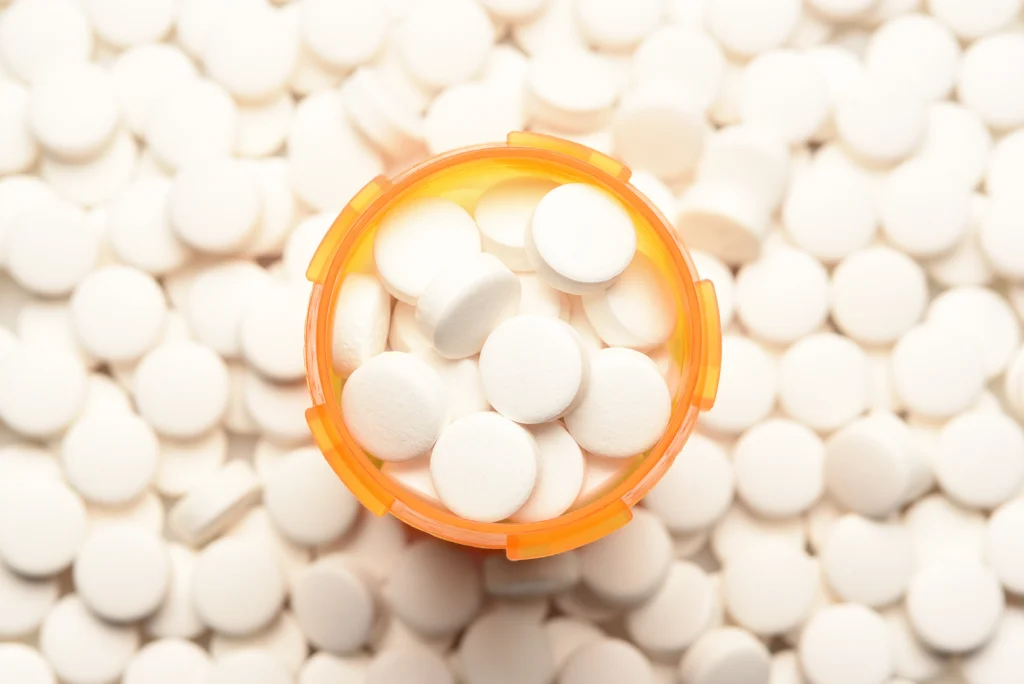All About Percocet
Percocet is the brand name of a narcotic combination analgesic legally available only by prescription. Especially over the past few years, counterfeit products resembling Percocet and its generic equivalents have been sold on the black market. These products often contain the far more powerful synthetic opioid fentanyl, disguised as pills illegally pressed to look like Percocet. This has resulted in countless tragic and unnecessary deaths throughout the country. An analog of a drug is something like a chemical cousin. These cousins can be far, far stronger than their parent compound.
Genuine Percocet and generic versions contain both oxycodone, a semi-synthetic opioid and the non-narcotic drug acetaminophen or APAP, commonly known as Tylenol. The idea is to combine two different painkillers for more effective pain relief. It’s also to try to get adequate pain relief with less oxycodone.
Percocet comes in four strengths of oxycodone: 2.5 milligrams, 5 milligrams, 7.5 milligrams, and 10 milligrams. The APAP component stays the same at 300 milligrams.
An Explanation of Opioids and Opiates: What’s the Difference?
Although the terms opiate and opioid are often used interchangeably, they’re not technically the same. An opiate is a naturally occurring narcotic compound found within the opium poppy. Specifically, these are most well-known as codeine, morphine and opium.
Although oxycodone is derived from the opium poppy alkaloid thebaine, it doesn’t naturally occur in the plant.
Therefore, oxycodone is not an opiate. It’s what is called an opioid, which is defined as a substance that can produce opiate-like effects within the body but isn’t naturally found in the opium poppy. Opioids may come from a natural source, or they may be totally synthetic. In fact, most are. Examples of these would be methadone, meperidine (Demerol) and fentanyl and fentanyl analogs. These drugs are entirely man-made in a lab from starting materials called precursors.
Opioids can come from other natural plant sources, too. A good example of this would be kratom, a plant in the coffee family that is native to Southeast Asia. Since kratom’s active compounds bind to and activate the brain’s opiate receptors, particularly the mu receptor (the MOR), it’s technically an opioid substance.
Kratom remains a controversial herb, often vilified by mainstream drug treatment professionals and the FDA. The DEA isn’t too fond of it, either and has placed it on a drugs of concern list. It’s banned in at least six states and several jurisdictions, including within the city limits of San Diego, California.
At the end of the day, the terms opiate and opioid refer mostly to the same things. You can call oxycodone by either term. Both work in the brain in essentially the same way.
What Is Oxycodone?
Oxycodone is a semi-synthetic opioid. Its production begins with a naturally occurring opium poppy compound called thebaine, in itself not a narcotic. Thebaine behaves in the body more like an edgy, hallucinogenic stimulant and has no direct medical use as such. However, its chemical structure is very close to that of oxycodone, so it’s chemically converted from thebaine to oxycodone in just a few steps. Oxycodone can also be made from codeine, although this process is more complicated.
Although addictive, oxycodone is an extremely effective painkiller even when taken by mouth. This is partly because it’s very resistant to the body’s attempt to neutralize it. In fact, up to an astonishing 80% of a taken dose will actually reach the brain. Once in the brain, oxycodone binds completely and firmly to the mu receptor. This is another reason why it relieves pain so well and also why it can be so addictive for some individuals.
Ironically, the drug was developed in a German laboratory in 1916 by a chemist trying to make a less addictive (compared to the morphine and heroin of the day) pain medication. The chemist reasoned that since thebaine isn’t a narcotic, a drug made from it wouldn’t be addictive, either.
He was wrong. The well-meaning chemist had inadvertently discovered one of the most addictive opioids of all time.
How Does Oxycodone Work?
Oxycodone, like all other opioids and opiates, works in the brain by interacting with a group of receptors sites known as opioid receptors. There are five of these:
- The mu receptor (MOR)
- The kappa receptor (KOR)
- The delta receptor (DOR)
- The nociception receptor (NOR)
- The zeta receptor (ZOR)
Of these, as far as opioids go, it’s the mu receptor that’s most associated with pain relief, sedation, euphoria, tolerance, addiction, overdose and death from overdose. It’s most closely associated with fatal overdose because the mu recruits a substance known as beta arrestin. Beta arrestin plays a strong role in overdose.
Overdose occurs when so much opioid has been ingested that it enters the brainstem and shuts down the breathing center located there.
Percocet in the United States
Oxycodone hit the German pharmaceutical market not long after its 1916 discovery under the trade name Eukodal.
Percocet took considerably longer to hit the American drug market. In fact, it wasn’t available for general use on a doctor’s prescription until 1971. However, it was available as an aspirin/oxycodone combination product under the trade name Percodan beginning in 1950.
The Hidden Danger of Percocet and Equivalent Generics
Although oxycodone can absolutely cause an overdose and even death if enough is consumed, the 2.5, 5, 7.5, or 10 milligrams present in the product are a relatively small amount that’s not even close to a lethal dose. This becomes a problem when people continue to take any narcotic drug such as oxycodone and develop a tolerance to it. As the body gets used to it, the liver develops enzymes to deactivate more and more of the dose.
At the same time, the brain’s opioid receptors become more and more resistant. This reduces the effect, prompting the user to increase the dose.
As tolerance rises, the individual must take more and more of the drug to get the same effect. Eventually, they must take very high doses just to get any effect and also to avoid withdrawal. As the person takes more and more Percocet to get more and more oxycodone, they’re also ingesting more and more APAP.
Why Is APAP So Dangerous?
In occasional therapeutic doses, Tylenol is probably fine for most people. The problem comes with people taking more than the recommended amount over a period of time or in an extremely high single dose. The safe limit for APAP for adults is no more than 1,000 milligrams every four hours with a maximum daily total of 4 grams or 4000 milligrams. (There are 1,000 milligrams in one gram).
Think about those figures. That means that at 300 milligrams of APAP per Percocet or Percocet generic pill, the safe single dose limit is reached at only three pills. For someone with a high tolerance, that’s not much. They need more. Even at the highest dose of 10 milligrams, that’s only 30 milligrams. While that’s huge dose for someone with no opioid tolerance, it’s not so much for someone with a high tolerance.
So people seeking a high take more. Then, more and more and more. After only 13 Percocet pills of any dose level, the person has nearly already reached the safe 4,000-milligram APAP limit for an entire 24-hour period.
The hepatotoxic (liver injury) dose of APAP may vary from person to person, but any single dose above 7.5 grams for an adult is potentially enough to severely damage or even destroy the liver.
Percocet: Addiction and Dependence
Daily consumption of any opiate or opioid over time will eventually cause the body to become dependent on the drug. This is because the addicted brain has become used to the constant presence of the opioid and can’t function normally without it.
While dependence and addiction are not the same, still, they very often occur together. Once a person has become physically dependent on an opioid, they will experience opioid withdrawal symptoms if the drug cannot be obtained or is otherwise suddenly stopped. These symptoms may include:
- Nausea and vomiting
- Anorexia
- Dehydration
- Stomach cramps and pain
- Restless leg syndrome
- Diarrhea
- Bone pain
- Anxiety
- Insomnia
- Cold sweats
Oxycodone withdrawal symptoms may persist from a few days to a week to over a month, depending on the individual and how much of the drug they were taking and for how long.
Treatment for Oxycodone Addiction: MAT
MAT means medication-assisted treatment. This involves using medications like Suboxone or methadone to relieve withdrawal symptoms and manage drug cravings. MAT can be highly effective, but for the best results, MAT must be combined with professional drug treatment therapy and counseling.
Simply going through oxycodone detox will rarely result in permanent sobriety, either. Almost everyone needs professional help to overcome addiction.
Charles River Recovery
Here at Charles River Recovery, we offer a wide variety of evidence-based treatments for opioid use disorder (OUD). Our professional staff of substance abuse and mental health experts are here to help you reach your goal of freedom from opioids. Some of our treatment methods are:
- MAT
- Inpatient and outpatient drug rehab treatment
- Individual and group counseling
- Support groups
- Aftercare programs
- Sober living
These are all evidence-based treatments, which means they’ve been proven to work.
Holistic Treatments
We also believe in treating the whole person, so we do offer some holistic options as well:
Yoga, art therapy, mindfulness, nutrition and acupuncture are all included in our holistic program. Acupuncture for OUD may be especially helpful because it’s thought to work by inducing the body to release its own natural opiates called endorphins.
Charles River Recovery is fully accredited. This is your assurance that our facility has been inspected, evaluated and approved by independent certification agencies like CARF and the Joint Commission. Only high-quality substance abuse treatment centers like ours receive this kind of accreditation.
We Can Help
Oxycodone addiction can be overcome with the right professional drug treatment. There is always hope. We invite you to visit Charles River Recovery to learn more. You can also call us at (844) 441-0455. A caring, trained staff member will be able to answer all your questions. We’re here to help you find your way to a brighter future that’s free of the misery of addiction.


